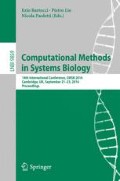Abstract
Computational models of cellular physiology are often too complex to be analyzed with currently available tools. By model reduction we produce simpler models with less variables and parameters, that can be more easily simulated and analyzed. We propose a reduction method that applies to ordinary differential equations models of voltage and ligand gated ion channels coupled to signaling and metabolism. These models are used for studying various biological functions such as neuronal and cardiac activity, or insulin production by pancreatic beta-cells. Models of ion channels coupled to cell biochemistry share a common structure. For such models we identify fast and slow sub-processes, driving and slaved variables, as well as a set of reduced models. Various reduced models are valid locally and can change on a trajectory. The resulting reduction is hybrid, implying transitions from one reduced model (mode) to another one.
Access this chapter
Tax calculation will be finalised at checkout
Purchases are for personal use only
References
Biktasheva, I., Simitev, R., Suckley, R., Biktashev, V.: Asymptotic properties of mathematical models of excitability. Philos. Trans. R. Soc. Lond. A Math. Phys. Eng. Sci. 364(1842), 1283–1298 (2006)
Bueno-Orovio, A., Cherry, E.M., Fenton, F.H.: Minimal model for human ventricular action potentials in tissue. J. Theoret. Biol. 253(3), 544–560 (2008)
Clewley, R.: Dominant-scale analysis for the automatic reduction of high-dimensional ODE systems. In: ICCS 2004 Proceedings, Complex Systems Institute, New England (2004)
Clewley, R., Rotstein, H.G., Kopell, N.: A computational tool for the reduction of nonlinear ODE systems possessing multiple scales. Multiscale Model. Simul. 4(3), 732–759 (2005)
Fenichel, N.: Geometric singular perturbation theory for ordinary differential equations. J. Differ. Equ. 31(1), 53–98 (1979)
Fridlyand, L.E., Jacobson, D., Kuznetsov, A., Philipson, L.H.: A model of action potentials and fast Ca 2+ dynamics in pancreatic \(\beta \)-cells. Biophys. J. 96(8), 3126–3139 (2009)
Fridlyand, L.E., Jacobson, D.A., Philipson, L.: Ion channels and regulation of insulin secretion in human \(\beta \)-cells: a computational systems analysis. Islets 5(1), 1–15 (2013)
Fridlyand, L.E., Philipson, L.H.: Pancreatic beta cell G-protein coupled receptors and second messenger interactions: a systems biology computational analysis. PloS one 11(5), e0152869 (2016)
Grosu, R., Batt, G., Fenton, F.H., Glimm, J., Le Guernic, C., Smolka, S.A., Bartocci, E.: From cardiac cells to genetic regulatory networks. In: Gopalakrishnan, G., Qadeer, S. (eds.) CAV 2011. LNCS, vol. 6806, pp. 396–411. Springer, Heidelberg (2011)
Hille, B.: Ion Channels of Excitable Membranes. Sinauer, Sunderland (2001)
Hodgkin, A., Huxley, A.: Propagation of electrical signals along giant nerve fibres. Proc. R. Soc. Lond. Ser. B Biol. Sci. 140, 177–183 (1952)
Holmes, M.H.: Introduction to Perturbation Methods, vol. 20. Springer Science & Business Media, New York (2012)
Iyer, V., Mazhari, R., Winslow, R.L.: A computational model of the human left-ventricular epicardial myocyte. Biophys. J. 87(3), 1507–1525 (2004)
Keener, J.P.: Invariant manifold reductions for Markovian ion channel dynamics. J. Math. Biol. 58(3), 447–457 (2009)
Keener, J.P., Sneyd, J.: Mathematical Physiology, vol. 1. Springer, New York (1998)
Lagerstrom, P., Casten, R.: basic concepts underlying singular perturbation techniques. SIAM Rev. 14(1), 63–120 (1972)
MATLAB: version 1.7.0_11 (R2013b). The MathWorks Inc., Natick, Massachusetts (2013)
Murthy, A., Islam, M.A., Bartocci, E., Cherry, E.M., Fenton, F.H., Glimm, J., Smolka, S.A., Grosu, R.: Approximate bisimulations for sodium channel dynamics. In: Gilbert, D., Heiner, M. (eds.) CMSB 2012. LNCS, vol. 7605, pp. 267–287. Springer, Heidelberg (2012)
Noel, V., Grigoriev, D., Vakulenko, S., Radulescu, O.: Tropical geometries and dynamics of biochemical networks application to hybrid cell cycle models. Electron. Notes Theoret. Comput. Sci. 284, 75–91 (2012). In: Feret, J., Levchenko, A. (eds.) Proceedings of the 2nd International Workshop on Static Analysis and Systems Biology (SASB 2011). Elsevier
Noel, V., Grigoriev, D., Vakulenko, S., Radulescu, O.: Tropicalization and tropical equilibration of chemical reactions. In: Litvinov, G., Sergeev, S. (eds.) Tropical and Idempotent Mathematics and Applications, Contemporary Mathematics, vol. 616, pp. 261–277. American Mathematical Society (2014)
Radulescu, O., Gorban, A.N., Zinovyev, A., Noel, V.: Reduction of dynamical biochemical reactions networks in computational biology. Front. Genet. 3(131) (2012)
Radulescu, O., Swarup Samal, S., Naldi, A., Grigoriev, D., Weber, A.: Symbolic dynamics of biochemical pathways as finite states machines. In: Roux, O., Bourdon, J. (eds.) CMSB 2015. LNCS, vol. 9308, pp. 104–120. Springer, Heidelberg (2015)
Radulescu, O., Vakulenko, S., Grigoriev, D.: Model reduction of biochemical reactions networks by tropical analysis methods. Math. Model Nat. Phenom. 10(3), 124–138 (2015)
Samal, S.S., Grigoriev, D., Fröhlich, H., Weber, A., Radulescu, O.: A geometric method for model reduction of biochemical networks with polynomial rate functions. Bull. Math. Biol. 77(12), 2180–2211 (2015)
Soliman, S., Fages, F., Radulescu, O.: A constraint solving approach to model reduction by tropical equilibration. Algorithms Mol. Biol. 9(1), 1 (2014)
Suckley, R., Biktashev, V.N.: The asymptotic structure of the Hodgkin-Huxley equations. Int. J. Bifurcat. Chaos 13(12), 3805–3825 (2003)
Tang, Y., Stephenson, J.L., Othmer, H.G.: Simplification and analysis of models of calcium dynamics based on IP3-sensitive calcium channel kinetics. Biophys. J. 70(1), 246 (1996)
Tikhonov, A.N.: Systems of differential equations containing small parameters in the derivatives. Matematicheskii Sbornik 73(3), 575–586 (1952)
Wechselberger, M., Mitry, J., Rinzel, J.: Canard theory and excitability. In: Kloeden, P.E., Pötzsche, C. (eds.) Nonautonomous Dynamical Systems in the Life Sciences. LIM, vol. 2102, pp. 89–132. Springer, Switzerland (2013)
Acknowledgments
This work was supported by the University of Chicago and by the FACCTS (France and Chicago Collaborating in The Sciences) program. The authors express their gratitude to the reviewers for their many helpful comments.
Author information
Authors and Affiliations
Corresponding author
Editor information
Editors and Affiliations
Rights and permissions
Copyright information
© 2016 Springer International Publishing AG
About this paper
Cite this paper
Sommer-Simpson, J., Reinitz, J., Fridlyand, L., Philipson, L., Radulescu, O. (2016). Hybrid Reductions of Computational Models of Ion Channels Coupled to Cellular Biochemistry. In: Bartocci, E., Lio, P., Paoletti, N. (eds) Computational Methods in Systems Biology. CMSB 2016. Lecture Notes in Computer Science(), vol 9859. Springer, Cham. https://doi.org/10.1007/978-3-319-45177-0_17
Download citation
DOI: https://doi.org/10.1007/978-3-319-45177-0_17
Published:
Publisher Name: Springer, Cham
Print ISBN: 978-3-319-45176-3
Online ISBN: 978-3-319-45177-0
eBook Packages: Computer ScienceComputer Science (R0)

